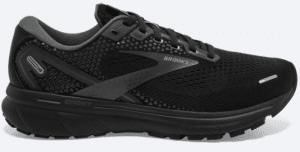Shoe Features
Insole – A removable insole liner will allow extra depth for an insole/orthotics.
Fastening – Laces might need to be loosed at pressure pain points. Slip on shoes can be tighter in places which isn’t helpful if your foot hurts.
Upper and linings – A soft upper can be useful when managing foot pain- stretch materials can help reduce pressure on painful joints or hot spots.
Heel counter – This provides support around the heel of the shoe to stabilise the foot. Often a stable heel counter can be useful with painful feet. A shallow heel counter is unlikely to have the depth for a foot insole.
Toe Box – This should be wide enough not to squash toes and deep enough to allow your toes to wriggle in the shoe. Extra depth can accommodate a hammer toe or an arthritic big toe joint.
Heel – The heel of the shoe should be broad and not too high. A hard material will be less forgiving if your heel is painful.
Forefoot Rocker Sole – The front curve can aid walking especially if have forefoot pain such as a stiff big toe joint or painful ball of the foot.
Width – Appropriate width is important to avoid compression of a bunion or arthritic big toe joint.

